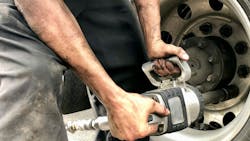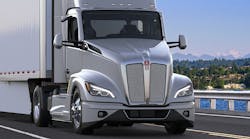Rohlwing: Key factors affecting safety when lifting commercial motor vehicles for tire service
Key takeaways
- Lifting commercial vehicles carries inherent risks that can be managed with proper procedures and awareness.
- Ground stability, vehicle positioning, and correct use of jacks and jack stands are critical for technician safety.
- Fleets should require manufacturers to identify lifting points and train technicians to prevent accidents.
Commercial truck tire technicians have to accept a certain amount of risk. Safety and training procedures exist to minimize the risk, not eliminate it. There are just certain aspects of the job that add an element of danger.
I’ve always described it by saying that lightning can strike during a thunderstorm on a golf course—but there is a difference between staying in the clubhouse, standing under the designated shelter, standing under a tree, or standing in the middle of the fairway waving a 5-iron in the air. There are different risk levels with each approach.
Understanding the risks of lifting commercial vehicles
Lifting commercial motor vehicles poses significant risks for technicians who service truck tires. Several factors influence the risk, including the ground condition, vehicle position, and the equipment used to raise the axle.
Ground conditions can be controlled. Ideally, it is firm and flat. If it isn’t firm, then steel or composite plates can be placed under the lifting equipment to increase the surface area and improve stability when the axle is off the ground. If it isn’t flat and cannot be adjusted, then the vehicle needs to be moved to level ground.
The position of the vehicle plays a significant role in achieving a safe lift. I don’t know the physics of why a vehicle parked on the shoulder physically moves when a tractor and trailer zooms by at highway speed in the far right lane, but I’ve been there when it happens. If the disabled truck cannot be safely positioned on the shoulder with enough space between the wheel position and the fog line, then it needs to be moved.
Best practices for safe jack and jack stand use
Equipment is another controllable aspect of raising an axle for tire service. Hydraulic jacks are designed to lift and position. Jack stands are designed to support the weight of the axle. When a jack is used without a jack stand, the internal plastic ring at the end of the ram is the primary support mechanism. Most vehicle lifting fatalities occur when a hydraulic jack is used without a jack stand and fails, or the vehicle slips off the jack. There have been a few accidents where the truck slips off the jack stand, but these are usually caused by unstable/uneven ground, mechanical failure, or a change in the vehicle’s weight distribution.
Since the jack and jack stand combination is a critical component of vehicle lifting safety during truck tire service, the position of the equipment is equally important. On standard straight-axle trailers, it’s fairly easy to position the jack and jack stand at the end of the axle so that the jack can lift the vehicle and then be released, allowing the jack stand to support the weight. The same can be said for most steer axles. Using the golf analogy, it’s a tap-in putt.
Drive axles are often more complicated because there’s only one flat space for the jack or jack stand. Drivetrain manufacturers are not in favor of using the differential as a lifting point, which would make the process a lot easier and safer. This forces the technician to either lift at the flat space on the end of the axle and support it on the angled space between the suspension and the differential, or lift the differential, and hope nothing breaks.
During thunderstorms, specialty trailers, coach buses, and car haulers are 5-irons in the fairway. The manufacturers do not provide the spaces for a jack and jack stand, nor do they identify designated lifting or support points. It’s not that they haven’t been asked because I have been actively seeking guidance for over a decade. I’ve actually spoken with engineers on trade show floors to point out the fact that there is no place for a jack and jack stand on the vehicle. They always say they will get back to me.
I’ve been in the business long enough to know that fleet customers have the leverage to get information that no one else can get. Every fleet should require manufacturers to identify the lifting and support points for each vehicle and ensure that technicians performing tire or mechanical services are aware of the proper lifting procedures. If air suspensions need to be disabled, the driver should be aware of the process so it can be communicated effectively, as technicians shouldn’t have to work during thunderstorms.
About the Author
Kevin Rohlwing
Kevin Rohlwing is the SVP of training for the Tire Industry Association. He has more than 40 years of experience in the tire industry and has created programs to help train more than 180,000 technicians.


